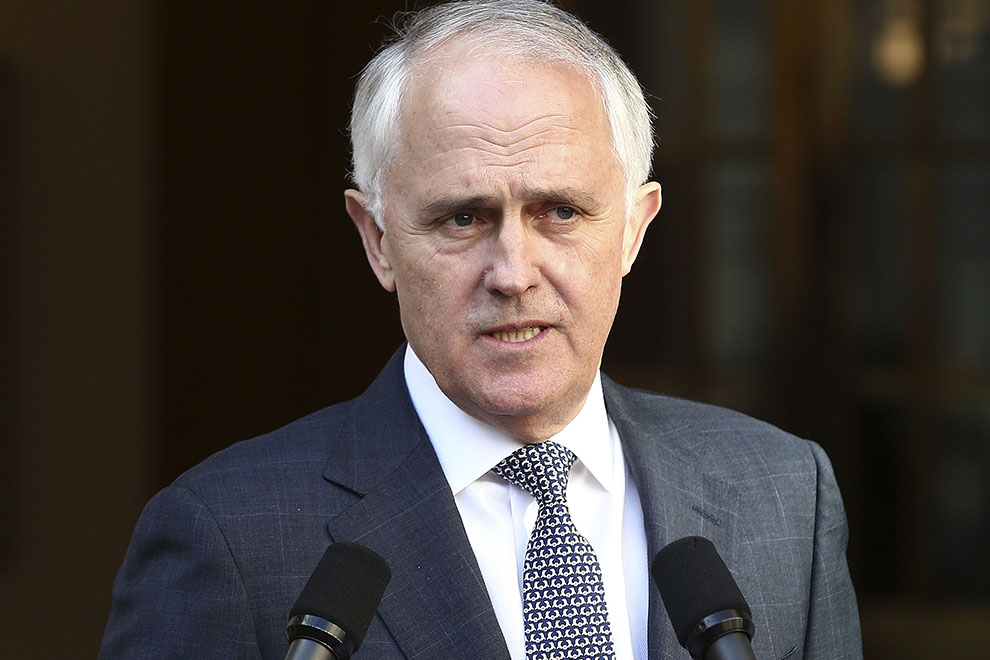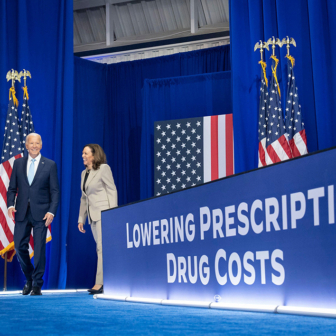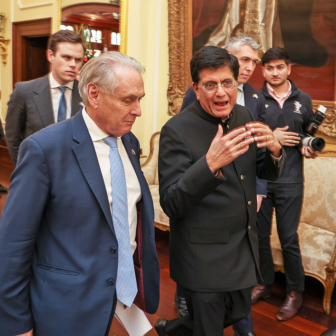Updated 30 September 2015
Malcolm Turnbull is saying all the right things about tax reform. He tells us it will be a top priority for his government. That all options are on the table. That if we get it right, we can lift our rate of economic growth and improve our wellbeing.
This week he will meet with unions, business and representatives of youth organisations and the aged to make preliminary soundings about areas of agreement and potential sticking points.
There’s so much to be fixed. We raise too little revenue to pay for our spending – the Abbott government has run up an operating deficit of $38 billion – and the Intergenerational Report warns of endless deficits ahead as the population ages. Our tax system is unfair, unnecessarily complex, and riddled with inconsistencies and loopholes vulnerable to those with smart accountants.
And if the secret to success is to “work, save and invest,” as treasurer Scott Morrison tells us, then the tax system offers us the wrong incentives. It punishes mothers who return to work, encourages us to retire early, overtaxes bank deposits while rewarding debt with unlimited deductions, and encourages us to invest in driving up house prices rather than fostering startup enterprises.
Further, there are growing signs that hardcore tax avoidance – actions whose sole or main purpose is to avoid tax – is moving from the fringe to the mainstream in corporate Australia, as in the rest of the world. Only wage and salary income remains fully taxed; the system offers investors many ways to dodge tax on their earnings, and offshore tax havens are adding to the options for corporates.
The assumption that lower tax rates alone would change that behaviour is wishful. But lower tax rates financed by plugging the loopholes certainly worked in Australia and the United States in the 1980s, and it remains the main game for any serious plan for tax reform.
Turnbull is off to a good start. He has declared his commitment to making tax reform work – as he did a decade ago, when he produced options for lower tax rates paid for by closing loopholes. They were applauded by economists, but rejected with ridicule by then treasurer Peter Costello.
Costello saw tax reform through the prism of realpolitik. He once remarked, “People don’t think it’s tax reform if you’re increasing their taxes.” And since virtually all worthwhile tax reforms would make some people worse off, and they would complain, the near-death experience of the GST killed his interest in doing anything more.
Well, realpolitik still rules. No one should underestimate the difficulty of designing a tax reform package that will work both politically and economically. Massive difficulties stand in the way, particularly if the Turnbull government tries to do it the way we usually do politics in Australia: on a partisan basis.
You see it all the time. If one side proposes a tax change, the other side opposes it. That was also true in the 1980s and 1990s, when the Coalition opposed virtually every revenue-raising element of Labor’s tax reforms: the fringe benefits tax, the capital gains tax, compulsory superannuation and so on. And it was true when Labor opposed the introduction of the GST in any form.
Tax reform in those decades was possible only because the Australian Democrats, a responsible centre party, held the balance of power in the Senate, and gave it their support to push it through. But there are no Democrats now. In the current Senate, which will run until mid 2017, the Coalition needs the support of either the Greens or six of the eight crossbenchers to pass any bill Labor opposes. The government is unlikely to be in a stronger position in the Senate after the next election, and may well be even worse off.
And if a higher and/or wider GST is to be part of the package, in effect that also requires agreement with the states – half of which have Labor governments, and all of which have separate, often conflicting, agendas. Think of Tasmania and Western Australia.
Australians who have their tax lurks closed will erupt in a loud, sustained fury, drowning out the more reasonably expressed support for the package. The Murdoch empire, which has made heavy use of offshore tax havens, can be expected to campaign in its usual style against any moves to close off avenues for tax avoidance.
In the court of public opinion, tax reform is a battle that is very hard to win. The reformers are always the underdogs.
Yet with imaginative leadership – and, critically, a supportive party – that weakness could be made into a source of strength. With an honest, fair-minded, moral approach, it could become one of those causes that snowball until other politicians and interest groups dare not stand in its way: as it did in the United States in 1986, especially after President Reagan climbed off the fence to give it his support (not to be confused with his earlier, disastrous flirtation with the Laffer Curve).
What if Turnbull decided at the outset that, given the degree of difficulty, he would not attempt tax reform on a partisan basis? What if he tried to persuade Labor and the states to tackle it together, on a bipartisan basis?
Sure, that has a cost. It would mean abandoning the Liberals’ successful tradition of using lower taxes as a form of brand differentiation to wedge voters against Labor. That partisan branding would have to be set aside, at least temporarily, in the interests of the bigger goal of ensuring the nation a revenue system that will be sustainable over the long term.
Success would bring its own political rewards. All governments have a common interest in ensuring they have adequate revenue to meet their spending commitments.
With skill, and luck, Turnbull could persuade Labor and Coalition leaders, state and federal, to join him in thrashing out reforms that could right the tax system, streamline our impossibly complex federation – and, importantly, reduce the excessive polarisation of Australian politics and strengthen the centre against the extremes of partisanship.
So far, the public conversation has focused on the what of tax reform. That is natural, but for Turnbull and Morrison, it is just as important, and urgent, to focus on the how and when. Unless they are confident that they can win support for tax reform on a do-it-yourself basis, they need to work out first of all what role they want state governments and the opposition to play in designing the new system.
They will also need to decide whether to move fast on tax reform, while their popularity is still high, or allow time for the “national conversation on tax reform” to break down resistance to change. The political risks in delay would be minimised if the opposition is part of the process.
The potential gains are colossal: particularly if the deepening and widening of the GST is used to redraw the boundaries of federal and state responsibilities, to create a system in which the states have more independence and more control over the resources they need to do their job.
Greg Smith, chair of the Grants Commission, designed Australia’s dividend imputation system in the 1980s, and went on to head Treasury’s budget and revenue divisions before serving on the Henry tax review. At a conference on GST reform convened this month by the Tax and Transfer Policy Institute at the Australian National University, he said the first issue Turnbull and his team need to decide on – if the GST is to be raised or widened – is what the money is to be used for.
Smith noted that different interest groups are campaigning for the additional GST revenue to be used in five different ways:
- To compensate the states for the $80 billion and rising the Abbott government decided to cut from the federal government’s previously agreed share of health and education funding (cuts that neither Turnbull nor Bill Shorten has disowned).
- To shore up state revenues to meet the long-term health and welfare costs of our ageing population, as identified in successive Intergenerational Reports.
- To allow the states to scrap their worst taxes: stamp duties on conveyancing, insurance taxes, and possibly payroll tax.
- To finance income tax cuts by the federal government.
- To finance company tax cuts by the federal government.
“You can’t spend the same money five times,” Smith warned. He reminded reformers that even with the polls showing rising support for lifting and/or widening the GST, 58 per cent of the electorate is still against it. The question of how the money is to be used, he said, will be crucial to winning acceptance.
(Why could both Canberra and the states help themselves to the additional GST revenue? First, while the GST is a federal tax, all the money is passed on to the states; it is by far their single biggest revenue source. But, second, on top of $57 billion a year in untied GST grants, Canberra intervenes in dozens of state responsibilities, handing over $50 billion a year of tied grants for schools, hospitals, roads and much more. To have two governments running the same policy areas is increasingly seen as an indulgence. While Canberra rarely gives up any power, passing on bigger GST revenues to the states would give it a perfect excuse to withdraw tens of billions a year of tied grants and use the money to pay for income and/or company tax cuts.)
But as a number of speakers at the ANU conference pointed out, whether the tax package succeeds or fails depends on whether the public – and possibly, crossbenchers – are convinced that it is fair. The idea in business circles that you can lift the GST simply to pay for cuts in company tax or the upper rates of income tax is politically ludicrous.
Ben Phillips of the National Centre for Social and Economic Modelling pointed out that most income tax (61 per cent, in fact) is paid by the top 20 per cent of taxpayers. By contrast, the GST is “mildly regressive,” because low-income earners spend all they earn but high-income earners save much of their income.
While an across-the-board income tax cut of 10 per cent sounds neutral, Phillips said, it would leave the top 20 per cent better off and everyone else worse off. A compensation package targeted at low-income earners, as many people advocate, would soak up about a third of the revenue raised, yet would still leave middle-income earners significantly worse off.
“Compensation will be complex and expensive,” Phillips concluded. “Income tax cuts would need to be biased towards those on lower and middle incomes.” That’s not the way Coalition governments normally deliver tax cuts. Scott Morrison’s initial comments implied he wants to give priority to tax cuts for those at the top.
Paul Abbey, senior tax partner at KPMG, has been modelling possible packages and sounding out key players. He told the conference that civil society groups would oppose any package that didn’t tackle the sacred cows of Australia’s tax system, such as negative gearing and the privileged tax treatment of superannuation, capital gains and family trusts. “Unions and charities are looking for some of the sacred cows to be slaughtered,” he said.
And with good reason. The Bureau of Statistics’ latest study of income distribution found that the top 20 per cent of income earners gained almost 80 per cent of all the growth in after-tax income in the two years to 2012–13. Since the start of the Howard era, their share of Australians’ after-tax income has grown from 37 per cent to 41 per cent, while the shares of all other groups have shrunk.
None of the conference speakers opposed the idea of a tax package that raises and/or widens the GST while cutting income and/or company tax. Their argument is that it will be very difficult, and therefore will have to be done with great care. It will have to give priority to fairness. It will have to recruit the widest possible coalition of supporters. The how and the when will matter as well as the what.
Senior Treasury tax guru David Pearl, currently on secondment to KPMG’s tax-reform taskforce, said that above all the government must ensure that it wins the public’s trust. In the recent past, he said, “both sides [of politics] have proposed tax changes without making any serious effort to explain them. Both have used models in ‘gotcha!’ ways. Both have dismissed legitimate concerns, and displayed an absence of frankness… It is understandable that the community is sceptical.”
A successful tax reform package offers the opportunity to improve our economic future, and change the way we are governed. Achieving it will be a supreme test of Malcolm Turnbull’s political skills. •




